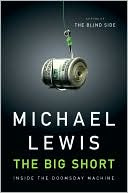More on Michael Lewis' Book
Reuters has a very interesting video q&a with Michael Lewis, now on its website. You can find it at: http://live.reuters.com/Event/Live_chat_with_Michael_Lewis
Eyesight to the Blind
Henry Paulson admits he didn’t see the meltdown coming. In his memoir On the Brink, the former Treasury Secretary describes a 2006 meeting of the White House economic team at Camp David, where he warned of the possibility of a coming economic “disruption,” which he said was overdue. But, he adds, “I misread the cause, and the scale, of the coming disaster. Notably absent from my presentation was any mention of problems in housing or mortgages.”
So if Paulson missed it, and Treasury Secretary to-be Timothy Geithner missed it, and Fed chairman Ben Bernanke missed it…who saw the cataclysm coming?
In the words of Michael Lewis, only a handful of unusual, “almost by definition odd” outsiders were able to look past the conventional wisdom and see the subprime-mortgage-inflated market for what it was. Lewis profiles this tiny group who were able to “see the ugly facts and respond to them” — and thereby make a killing even as most of Wall Street was decimated–in his new book, The Big Short: Inside the Doomsday Machine (Norton, $27.95). My review of this very informative and, believe it or not, entertaining book appears today on Reuters at http://blogs.reuters.com/great-debate/2010/03/11/michael-lewis-big-short-an-unsettling-experience/.
As is common with Lewis, there are some funny bits — but given the subject matter, the volume could hardly be a laugh riot. After all, fortunes were destroyed and many, many people were financially ruined. Still, consider this passage, where the author describes his protagonists’ hunt for the worst subprime-mortgage-backed bonds, which they were preparing to short: “Looking for bad bonds inside a CDO [or collateralized debt obligation] was like fishing for crap in a Port-O-Let: the question wasn’t whether you’d catch some but how quickly you’d be satisfied you’d caught enough.”
That’s typical of Lewis’s not-for-family-hour prose. Darkly funny stuff. And also highly insightful. For a writer who made his reputation on claims that he knew nothing about nothing when hired to work on Wall Street in the ’80s, somehow Lewis has learned a great deal about some very sophisticated investing.



